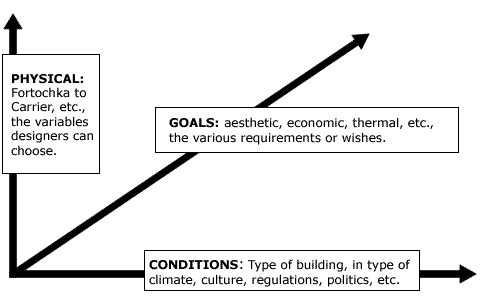Climatic Regulation for the 21st Century
Student competition—stage 2 (2005 / 2006)
20th April 2006
Practical matters
We continue!
The following projects have been selected:
- Method Rastrelli for inhabited multi-storey building in St. Petersburg
- Applications of elements “Fortochka”, “Palladio” at designing
- Method “Dagmara” in the Hermitage Climatic Regulation
- Methods of securing microclimate parameters using evaporative cooling
- “Fortochka” for existing buildings
- An artificial tree
- Harmony
- Wonderland
Conditions:
No new projects. New students can assist the existing projects, if existing participants agree.
Develop project ideas, within existing main scope, but with freedom for creativity.
Main assessment criteria are logos, pathos, ethos, and “Magritte” (think differently).
General P_C_G Framework
Climatic regulation has several dimensions. Students can choose freely, within their main scope, or ask for a suggestion. On one axis can be described the 9 design principles, which are (dependent) variables, each with several design possibilities. These can be applied to a number of different building types in many climatic and cultural (legislative) zones to form a 2 dimensional picture. On the third axis come the various climatic factors we may wish to influence, broadly within the ethos-pathos-logos framework, with sub-divisions for aesthetic or psychological considerations, thermal-, chemical-, moisture pollutants, light, sound, particles, and all the sensory elements. Broadly speaking, these 3 dimensions can be described as the how-where-why axes. How (physical), where (conditions), why (goals).

Generally, students have chosen Russian boundary conditions, but an attempt at an objective analysis of the relevance of their project under other climatic, cultural, legislative etc. frameworks could be beneficial to understand possibilities and barriers.
Some students have selected one specific physical variable; others have selected a range of variables, but whichever choice has been made it may be beneficial to assess the implication of the selected design of one variable on the others.
Some projects have considered one or more of the possible goals that can be achieved, but for the next stage it will be important to assess the balance between all the various goals: logos, pathos, ethos, and the various sub-goals under them.